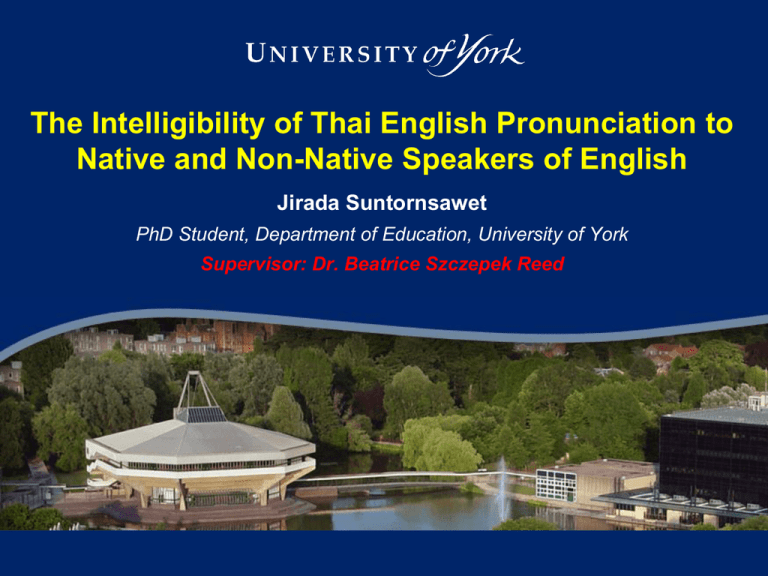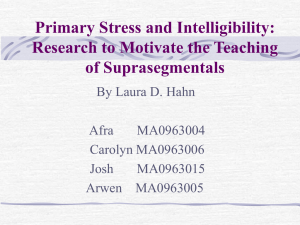The Intelligibility of Thai English Pronunciation to
advertisement

The Intelligibility of Thai English Pronunciation to Native and Non-Native Speakers of English Jirada Suntornsawet PhD Student, Department of Education, University of York Supervisor: Dr. Beatrice Szczepek Reed Background of the Problems I am an Indian, very brown, born in Malabar, I speak three languages, write in two, dream in one. Don’t write in English, they said, English is not your mother-tongue. Why not leave me alone, critics, friends, visiting cousins, Everyone of you? Why not let me speak in any language I like? The language I speak becomes mine, its distortions, its queernesses, all mine, mine alone. It is half English, half Indian, funny perhaps, but it is honest. It is human as I am human, don’t you see? It voices my joys, my belongings, my hopes. And it is useful to me as cawing is to crows or roaring is to lions, It is human speech, the speech of the mind that is here and not there, A mind that sees and hears and is aware. not the deaf, blind speech. (Kamala Das: ‘An Introduction’, 1965) Introduction Standard English Only Standard English will be appropriate in all contexts of English language use. (Quirk, 1985: 1) Standard English as King English. (Phillipson, 1992) Native English possesses no less intelligibility than indigenous English accents. (Trudgill, 2003) Introduction Non Standard English Allowance Concentric Circles of English Users (Krachu, 1962) English does not belong to any specific group of people but it belongs to whoever the interlocutor is. (Kirkpatrick, 2007) The Dynamic of New English (Schenider, 2007) Lingua Franca Core Concept (Jenkins, 2000) Introduction Kachru's Three Concentric Circles of English Literature Review Lingua Franca Core A theory arguing that some English speech sounds are more crucial than others in promoting communication Rather than possessing native-like pronunciation, non-native pronunciation is permissive as long as the intelligibility is reached. Literature Review Intelligibility Analysis Intelligibility Comprehensibility Recognition of words and utterance Ability to ascertain a meaning (Locutionary Force) Interpretability The degree to which one is able to perceive the intention behind another’s word of utterance (Illocutionary Force) (Smith, 1987) Literature Review Speech Intelligibility Testing Speech Recognition, Speech Understanding Needs to be qualitatively judged by human only (Holmes and Holmes, 2001: 210) Transcription Task: American Standard Method for Measurement of Monosyllabic Word Intelligibility Hawley (1977) Text Independent (Holmes and Holmes, 2001: 224) Subjective appraisal: Rating Scale Method (Egan, 1977) Research Questions 1. How does the degree of Thai accentedness – weak, moderate, and strong, in Thai English pronunciation have the impact on the intelligibility to different groups of English users; namely, a) English native speakers? b) English non-native speakers whose L1 is not Thai? c) English non-native speakers whose L1 is Thai? 2. Which specific pronunciation features of Thai English pronunciation cause the problem in the intelligibility to different groups of English users; namely, a) English native speakers? b) English non-native speakers whose L1 is not Thai? c) English non-native speakers whose L1 is Thai? Methodology Participants 9 English Language Users 3 English Native Speakers 3 English Non Native Speakers (non Thai L1) 3 English Non Native Speakers (Thai L1) Methodology Informants 2 Thai English Speakers (weak accent) 2 Thai English Speakers (moderate accent) 2 Thai English Speakers (strong accent) Audio Recorded Speech (10 mins) Controlled topic (Dissertation) Judges for Level of Accentedness 3 linguist experts 10 non-linguist experts Methodology Instruments Transcription Tasks Data Analysis: Transcription Tasks Accurate Transcription – Level of intelligibility possessed by each group of listeners Error Transcription – Phonological features to be focused in teaching English pronunciation for Thai students Data Analysis Intelligibility Level 100% 90% 80% 70% 60% NS 50% NNS NNST 40% 30% 20% 10% 0% weak moderate strong Data Analysis Problematic Phonological Features Segmental Features Consonants [dʒ] as [ʃ] – genre [z] as [s] - design [v] as [w] - environmental [θ] as [t] - there Data Analysis The pronunciation of unreleased final consonant [r], [t], [k], [z], [d], [n] [s] always replaced with unaspirated [t] [l] always replaced with glide [w] Replace rhotic [r] with lateral [l] – ‘lecturer’ Data Analysis Fail to produce certain group of consonant cluster [dr] as [dʷ] - dressing [fr] as [f] (drop [r]) - different [pl] as [pr] - applied Data Analysis Vowels Monopthongization [əʊ] as [ɔ] - approaches [ēə] as [e] - lesbianism Strengthen unstressed weak vowel [ə] as stressed vowel as [e], [a], [ɔ], [æ] Data Analysis Suprasegmental Features Stress: wrong placement of stress especially in the words with more than two syllables ‘literature’ ‘cinematic’ My Research Journey Obstacles It is inappropriate to judge the quality of any language as language is merely the tool for communication. Level of intelligibility should not be measured only in term of pronunciation. In fact, grammar, style, and fluency performed by individual speakers come to the play. Certain Thai English informants do not want to be the informant of the research. References Egan, P. J. (1977). Articulation Testing Methods. In Hawley, E. M. (Ed.), Speech Intelligibility and Speaker Recognition (pp. 175-202). Pennsylvania: Dowden, Hutchinson & Ross. Inc. Flege, J. 1980. Phonetic Approximation in Second Language Acquisition. Language Learning, 30: 117-134. Hawley, E. M. (Ed.), (1977). Speech Intelligibility and Speaker Recognition. Pennsylvania: Dowden, Hutchinson & Ross. Inc. Holmes, J. and Holmes, W. (2001). Speech Synthesis and Recognition. London: Taylor & Francis. Jenkins, J. (2000). The Phonology of English as an International Language: New Models, New Norms, New Goals. Oxford: Oxford University Press. Kirkpatrick, A. (2007). World Englishes: implications for International Communication and English Language Teaching. Cambridge: Cambridge University Press. Krachu, B. B. (Ed.), (1982). The Older Tongue: English Across Cultures. Ulbama, Illinois. University of Illinois Press. Quirk, R. (1985) The English Language in a Global Context. In Quirk, R. and Widdowson, H. G. (Eds), English in the World: Teaching and learning the language and literatures (pp. 1-6). Cambridge: Cambridge University Press. Phillipson, R. (1992). Linguistic Imperialism, Oxford University Press. Schneider, E. W. (2007). Postcolonial English: Varieties Around the World. Cambridge: Cambridge University Press. Smith, L (1987). Language Spread and Issues of Intelligibility. Georgetown University Round Table on Languages and Linguistics. Washington, D.C.: Georgetown University. Trudgrill, P. (2003). Native-Speaker Segmental Phonological Models and the English Lingua Franca Core. In Seidlhofer, B. (Ed.), Controversies in Applied Linguistics. (pp.78-96). Oxford: Oxford University Press. Thank You for Your Attention Questions & Comments







